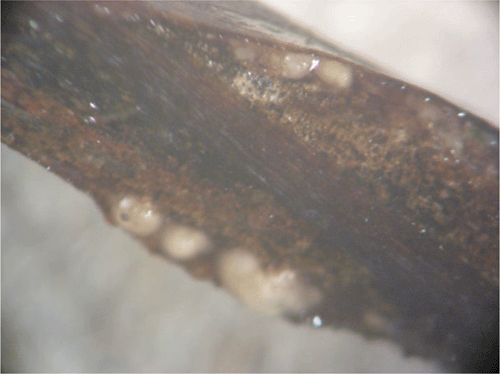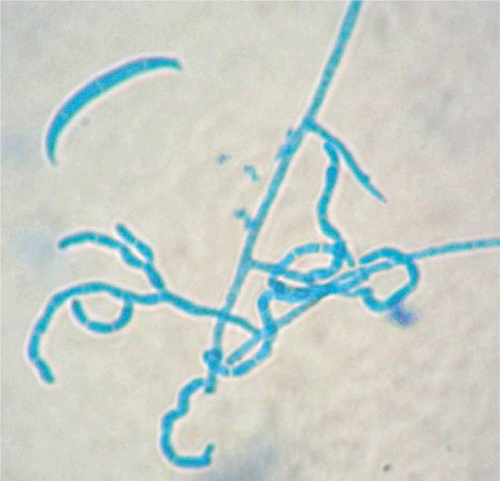First report of the pitch canker fungus Fusarium circinatum affecting Pinus taeda seedlings in Uruguay
R. Alonso A B and L. Bettucci AA Laboratorio de Micología Facultad de Ciencias-Facultad de Ingeniería, Universidad de la República Montevideo, Uruguay.
B Corresponding author. Email: raquela@fing.edu.uy
Australasian Plant Disease Notes 4(1) 91-92 https://doi.org/10.1071/DN09039
Submitted: 20 August 2009 Accepted: 26 August 2009 Published: 9 September 2009
Abstract
In recent years Pinus spp. plantations have become an important resource that is continuously increasing in Uruguay as well as in other countries. Fungal diseases in nurseries are common, and among them, Fusarium circinatum (the pitch canker fungus) was found associated with Pinus taeda seedling, representing the first record of this pathogen in Uruguay.
The pitch canker fungus Fusarium circinatum (Nirenberg and O’Donnell 1998) is a destructive pathogen that affects several Pinus species. Although the main symptom most frequently associated with this pathogen is the presence of large resinous cankers on the main trunk and lateral branches of trees, it can also be associated with roots, shoots, cones and seedlings (Barnard and Blakeslee 1980; Viljoen et al. 1994). This disease has been detected in south-eastern USA (Kuhlman et al. 1982), Mexico (Guerra-Santos 1999), South Africa (Viljoen et al. 1994), Chile (Wingfield et al. 2002), Spain (Peréz-Sierra et al. 2007) and other countries (Wingfield et al. 2008).
In Uruguay, forest plantation activity has increased over the last 20 years and the main exotic species planted are Eucalyptus spp. and Pinus spp. (Petraglia and Dell’Acqua 2006).
Nursery diseases are common and most of them are related to fungal pathogens. Recently, a symptom associated with Pinus taeda seedlings was observed. Needles of affected seedlings showed different stages of chlorosis ranging from pale green to reddish-brown discolouration. Stem and collar rot with bark cracks were detected and in some of them fungal sporodochia were observed (Fig. 1).

|
For the isolation of fungi associated with the stem lesions, segments of stems were placed in a moist chamber to stimulate mycelial development and also segments of affected tissues were surface disinfected (80% ethanol for 1 min and 2% sodium hypochlorite solution for 2 min) rinsed with sterile distilled water and placed in Petri dishes containing potato dextrose agar (PDA). From colonies belonging to Fusarium sp. single-conidium transfers were made to obtain pure cultures on PDA and Spezieller Nährstoffarmer agar (SNA) media allowing the identification to species level (Leslie and Summerrell 2006). Micromorphological characteristics, such as the presence of simple and proliferating conidiophores with polyphialides, microconidia in false heads, macroconidial shape, absence of chlamydospores and the typical sterile coiled hyphae (Fig. 2), led to the identification of Fusarium circinatum (Nirenberg and O’Donnell 1998; Britz et al. 2002). Molecular methods were also performed to verify the identification. DNA was obtained from fresh aerial mycelia by extraction with cetyltrimethylammonium bromide (CTAB), followed by organic extraction and isopropanol precipitation of the DNA using the method described by Lee and Taylor (1990). The intergenic spacer (IGS) region was amplified by the polymerase chain reaction (PCR) using the CIRC1A and CIRC4A species-specific primers (Schweigkofler et al. 2004). The amplicons were separated by electrophoresis in agarose gel (2%), stained with ethidium bromide (10 μg/μL), and visualised and photographed under ultraviolet light. The amplicon corresponded to the 360-bp fragment in accordance with those predicted for F. circinatum.

|
This is the first report of the presence of this pathogen in nurseries of Pinus taeda in Uruguay. This exotic pathogen was probably introduced with seeds since in field plantations symptoms have not yet been observed. On the other hand, a significant volume of Pinus timbers is not frequently imported.
Although the incidence in nurseries is low, the control and eradication of affected seedlings is very important in order to avoid the expansion of the pathogen into the field. Since other Fusarium species are very frequently found affecting several crops in Uruguay due to the cool and humid climatic conditions that favour the development of these fungi, monitoring of this disease has become necessary.
On the other hand, although some practices for disease control may include seedling destruction, application of chemical products or biological control agents (Mitchell et al. 2004), the best way to reduce the disease incidence seems to be the selection of plant-resistant genotypes to F. circinatum.
Barnard EL, Blakeslee GM
(1980) Pitch canker of slash pine seedlings: a new disease in forest tree nurseries. Plant Disease 64, 695–696.

Britz H,
Coutinho TA,
Wingfield MJ, Marasas WFO
(2002) Validation of the description of Gibberella circinata and morphological differentiation of the anamorph Fusarium circinatum. Sydowia 54, 9–22.

Kuhlman EG,
Dianis SD, Smith TK
(1982) Epidemiology of pitch canker disease in Loblolly-pine seed orchard in North Carolina. Phytopathology 72, 1212–1216.
| Crossref | GoogleScholarGoogle Scholar |

Mitchell RG,
Zwolinski J,
Jones NB, Coutinho T
(2004) The effect of applying prophylactic measures on the post-planting survival of Pinus patula in South Africa. Journal of Forest Science 200, 51–58.

Nirenberg HI, O’Donnell K
(1998) New Fusarium species and combinations within the Gibberella fujikuroi species complex. Mycologia 90, 434–458.
| Crossref | GoogleScholarGoogle Scholar |

Peréz-Sierra A,
Landeras E,
Leon M,
Berbegal M,
García-Jiménez J, Armengol J
(2007) Characterization of Fusarium circinatum from Pinus spp. in northern Spain. Mycological Research 111, 832–839.
| Crossref | GoogleScholarGoogle Scholar | PubMed |

Schweigkofler W,
O’Donnell K, Garbelotto M
(2004) Detection and quantification of airborne conidia of Fusarium circinatum, the causal agent of pine pitch canker, from two California sites by using a real-time PCR approach combined with a simple spore trapping method. Applied and Environmental Microbiology 70, 3512–3520.
| Crossref | GoogleScholarGoogle Scholar |
CAS |
PubMed |

Viljoen A,
Wingfield MJ, Marasas WFO
(1994) First report of Fusarium subglutinans f. sp. pini on seedlings in South Africa. Plant Disease 78, 309–312.

Wingfield MJ,
Jacobs A,
Coutinho TA,
Ahumada R, Wingfield BD
(2002) First report of the pitch canker fungus, Fusarium circinatum, on pines in Chile. Plant Pathology 51, 397.
| Crossref | GoogleScholarGoogle Scholar |

Wingfield MJ,
Hammerbacher A,
Ganley RJ,
Steenkamp ET,
Gordon TR,
Wingfield BD, Coutinho TA
(2008) Pitch canker caused by Fusarium circinatum – a growing threat to pine plantations and forest worldwide. Australasian Plant Pathology 37, 319–334.
| Crossref | GoogleScholarGoogle Scholar |



